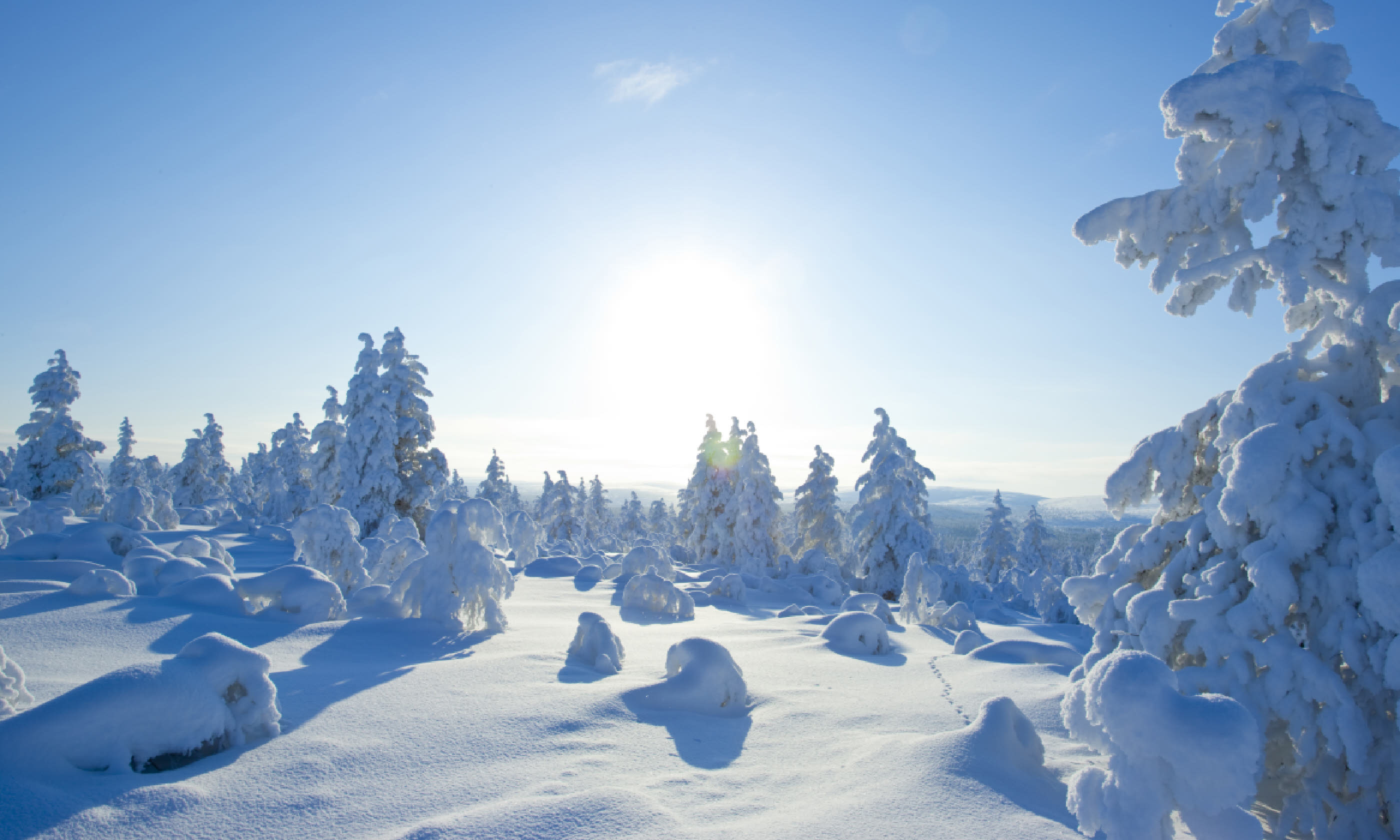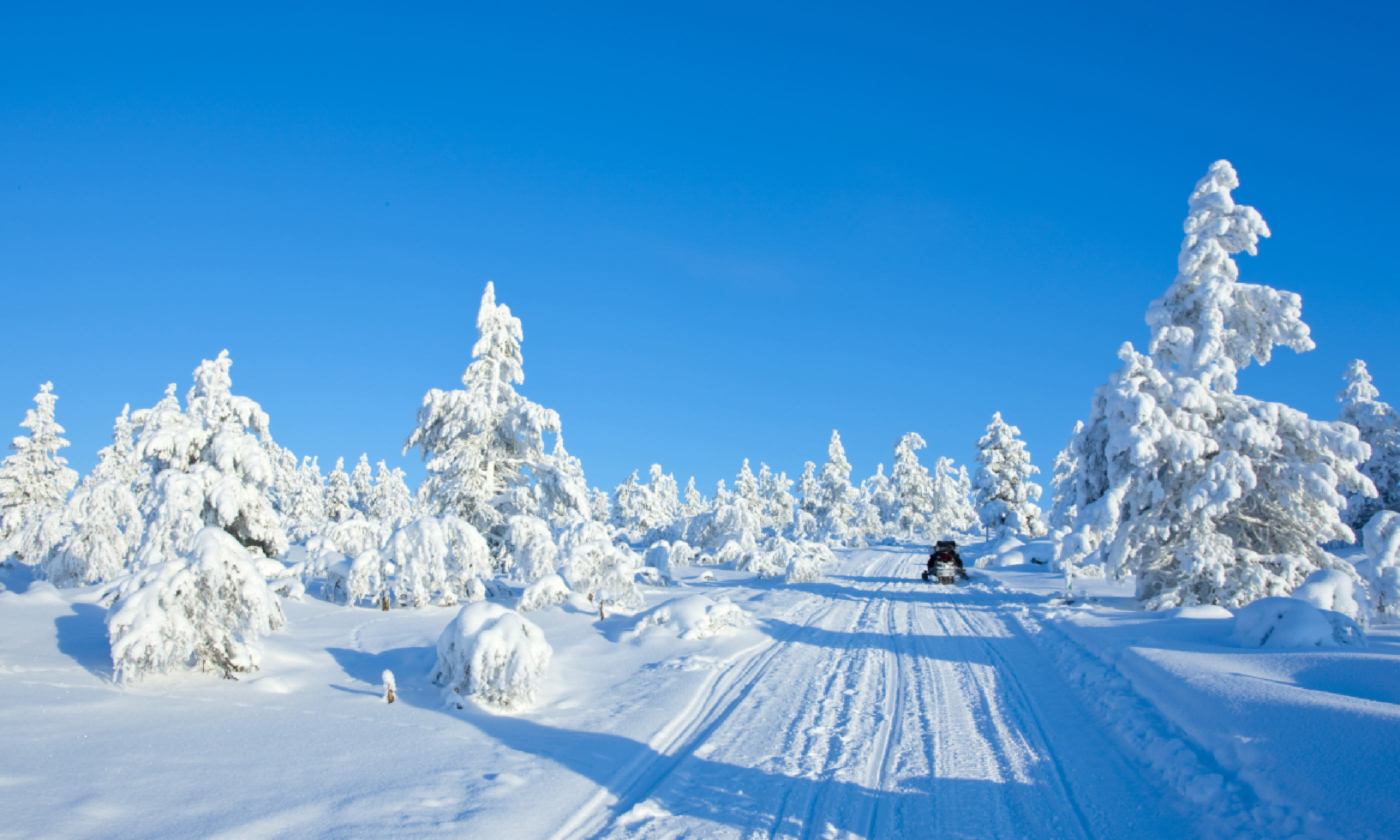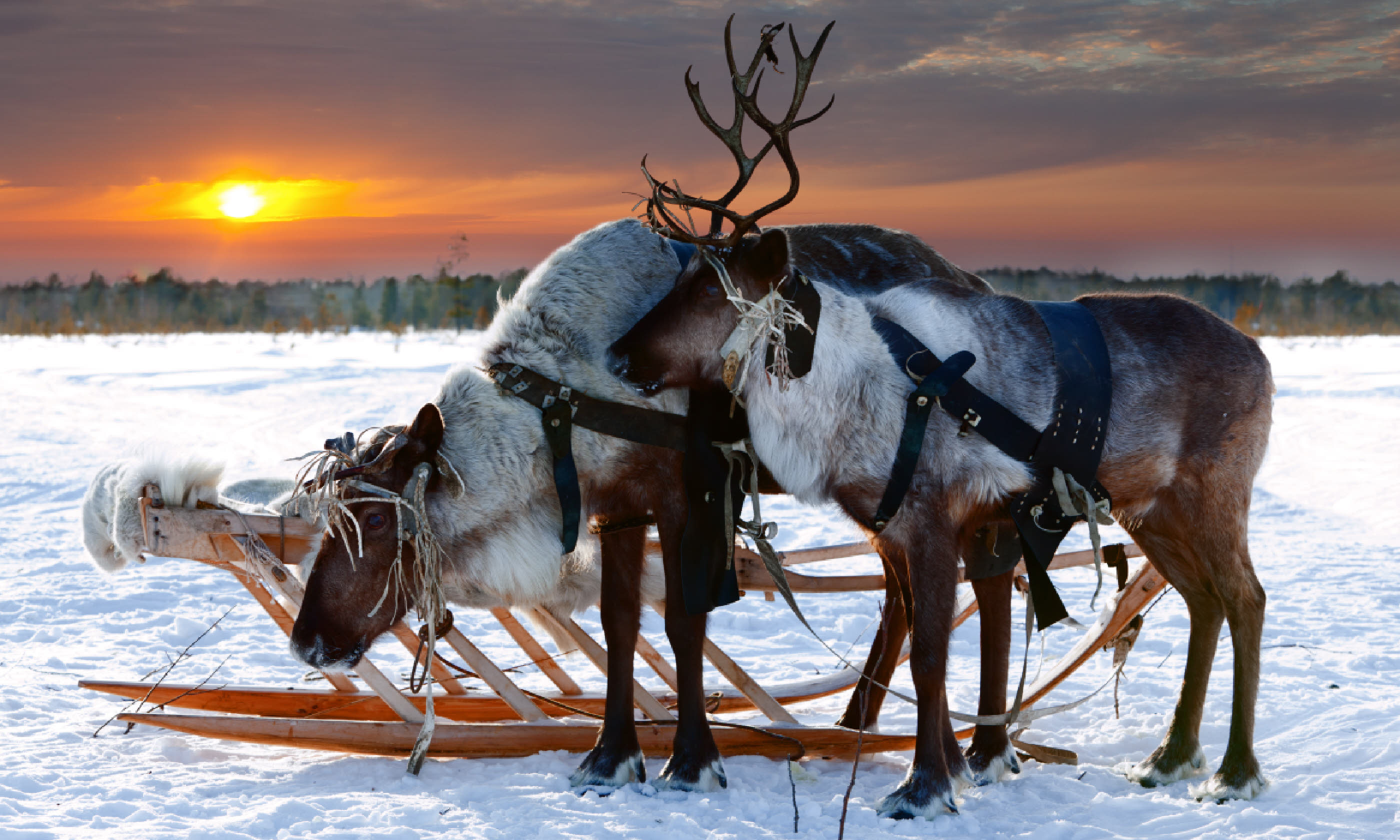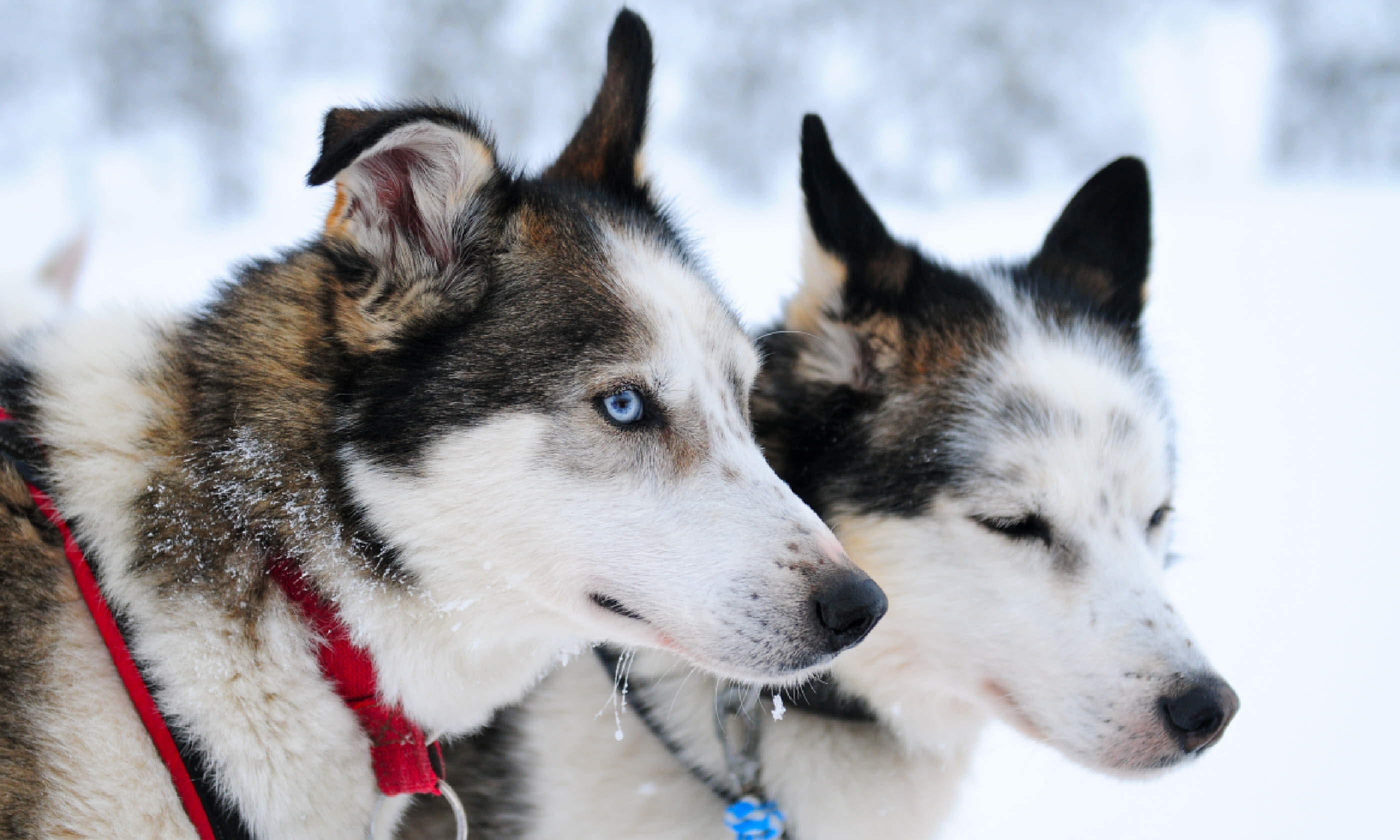
Up for a chilly challenge? Try Arctic sports and saunas in wintery Finland
For some reason, until I went to Finland, I’d always thought of a snowmobile as an uninspiring cross between a kiddy’s sled and a ride-on lawnmower. And, thus, I was fairly sure that snowmobiling itself would prove to be no more than a noisy way to rumble across an expanse of frozen tundra with all the swiftness of, say... well... a ride-on lawnmower.
So, I was surprised to find that even a standard hire-out snowmobile could putter along at well over 100km per hour. Which, based on the Laplander’s traditional rule of thumb that a sleigh-pulling Rudolph stops for a pee every six kilometres, works out at a speed of somewhere around 17 reindeer-pees-an-hour. Which is very fast indeed when you’re crouched over the controls of something as squat, unstable and clownish as a golf-buggy on skis. Not that I was ever able to work out exactly what speed my chrome and black machine, with its heated handlebars and burbling engine, actually managed to hit while I was at its controls.
“The speedometer doesn’t work,” I pointed out as I brought the snowmobile to a halt after a short, pre-trip test-drive around the dirtied-up snow of the Tahko hotel carpark. Mikko, who was kitting me out for a morning joyride over the frozen lakes and through the spruce and birch forests near the eastern Lakeland town of Kuopio, glanced over at the loops of stop-start skiddings I’d scribbled across the snow in a few brief minutes of high-revving enthusiasm.
He then looked back at me. “We’ve learnt to disconnect the speedos, otherwise inexperienced riders...” he narrowed his eyes, while I shifted uneasily inside my thickly insulated overalls, “...keep looking down to see how fast they’re going, and then, KRAAAASH, they run straight into a tree... ” he giggled, “or an elk...” he snickered, “...or Norway...!” Gasps of laughter condensed from his mouth in the -15°C temperature, hanging in the air like cartoon speech bubbles. Mikko, it seemed, didn’t fit the stereotype of the gloomy Finn – at one with the dark silence of the northern winter, and only a few bars of Sibelius away from suicide.
Jari, who was guiding me around all that Tahko had to offer in the way of snow-based fun, revved up his snowmobile. I did the same and our two machines accelerated towards the horizon like a brace of buzz saws ripping across an infinite sheet of white cartridge paper. And I realised immediately that I really shouldn’t be enjoying this snowmobiling lark, with all its elk-startling noise, acrid exhaust fumes and hooligan potential for speed. But I was.
As we built up speed across the marble smoothness of the lake’s frozen ice and then chicaned up a narrow track between snow-heaped trees, I whooped with joy and gunned the engine, forgetting that in Finland snowmobiles are just a necessary form of winter transport. Whooping on a snowmobile in Finland, therefore, is rather like getting excited back home if offered the chance to jump into a Toyota Corolla and nip down to the shops for a pint of milk.

Snowmobile in Finland (Shutterstock)
But then, even above the thrumming of my engine, I heard an echoing whoop. Jari had just whooped. Obviously it was fine to whoop. So, I whooped back. And I doubt if a single elk, or ptarmigan, or lynx, let alone any other person, heard even the ghost of a whoop, because there was, quite simply, no one around for miles.
Which was exactly why I’d come to Finland. Not specifically to shatter the silence of the northern lands (though that was as much fun as anything naughty ever is), but just because the Finns have more winter, and thus more snow, more frozen lakes and more sparkling, blue-skied emptiness, than anywhere else in Europe. And also because Finland spreads a population of a mere five million people across a land roughly equal in size to Germany (which has 82 million people though, admittedly, far better beer). So, what with having a third of its area above the Arctic Circle and a November-to-May snow season, when it comes to winter, wilderness and silence, the Finns have more than enough of all three to go around.
And another thing; Finland doesn’t really have mountains – its highest peak is 1,328 metres – and so it doesn’t have the best downhill skiing in the world. Which is just great because, though the numerous slopes the Finns do have are still good and provide all that’s needed in the way of powder snow, zippy lifts and prepared pistes, unlike most alpine ski resorts, the Finnish equivalents aren’t over-packed with stroppy locals, show-off ski-freaks and identikit slope-hogging family groups. Up north there’s enough of everything, even skiing, to go around.
But, better still, skiing isn’t the be-all-and-end-all of winter activity in Finland. Because when you get tired of going up hill slowly and then going down hill fast – over and over and over – you’ve got dog sledding, reindeer driving, lake ice-skating, cross-country skiing, ice fishing, winter horse riding, and ice-hole swimming to try out.
In fact, if there’s some way of sliding, falling, skidding, zooming or swooping across snow or ice and the Finns aren’t doing it, then you can bet they gave it a good try and it just plain didn’t work. The Finns even use snowshoes. Believe me, I’ve tried them – snowshoes come as close to ‘didn’t work’ as, say, salsa dancing while wearing flippers.
Unlike snowmobiles. Which work just fine. Jari and I straight-lined over the hills and lakes before, a few reindeer-pees out from Tahko, we cut the engines on top of a low peak. The sudden silence sifted in on our ears as we crunched, heavy-booted, through the snow to a point from where we could look out over a number of Finland’s 188,000 lakes.

Reindeer in a harness
“In Finland we mix the best of the new and the old,” Jari explained. “We use snowmobiles to get out to the wilderness and then we stop and turn the engines off. So there’s a chance to see wolverine, elk, wolves, bear and beavers. You can appreciate the emptiness and the peace. And, once you’re out here, then you can walk, ski, sledge or whatever.”
In Kuopio I managed to cross a whole lot of ‘whatevers’ off my ‘things-to-do-in-snow’ list. So, I skated, inelegantly, on Lake Kallavesi; cantered a tiny Icelandic ‘horse’ who energetically snow-ploughed his way through the drifts that rose up around his chest in a white flying spray; and I cross-country skied for two days, encouraged and tutored by Finnish ex-champion, Reijo Vornanen. Though I quickly discovered that, lacking his racehorse fitness, I was never going to get much beyond slotting my thin skis into the hundreds of kilometres of prepared ‘tram line’ tracks and gently pumping my way around a 20km circuit of breathtaking scenery, before reckoning it was time for a drink. Or two.
Apart from tasting the confusing variety of local alcohols (‘tar liquor’ made from the resinous sap of spruce, and mesimarja-likööri or ‘arctic cloudberry liquor’ among them), there were still some more ‘whatevers’ I wanted to try out in Finland’s frozen landscapes. But for those sports I was going to have to go even further north. Thus, the following winter found me in Levi, above the Arctic Circle in Lapland. This, the northernmost province of Finland, is home to the country’s small indigenous population of Sámi, the ‘reindeer people’.
The far northern snowlands seemed even more elemental and mysterious than those around Kuopio. On my first night in Levi, I listened to Sámi shaman Niils Jouni thudding out rhythms on an intricately decorated drum with a ptarmigan-leg while singing the melodies of Lapp joiku songs. It was a strange music that resonated uneasily within the walls of a warm room as an accompaniment to glasses of wine and plates of food. But travelling to the Sámi village of Harjula early the following morning, I could see that Jouni’s timeless, reindeer-paced keening complimented and appeased the endless monochrome silence perfectly.
In Harjula, men dressed in merry red and blue felt costumes were harnessing reindeer between the narrow shafts of sleighs like little cockle-shell boats. A plump rump and scutty little tail bobbed above Senja (my companion sleigher) and I as we sat back amidst deer hide blankets. I flicked the single rein running to the beast’s head-collar and ran through a repertoire of animal accelerating noises.
Our reindeer began stalking forward at a not-very-brisk pace. I redoubled my ‘aaarrggghhs’ and ‘chirruping’ clicks and ‘kissy kissy’ sounds. The deer broke into a shambling trot, his wide, splayed feet making a soft ‘thrumping’ in the snow, like the sound of pushing one’s fist very slowly, though repeatedly, into a feather pillow. We were going slower than the coming of spring.
In the village restaurant we ate bowls of ukko hutun ketto – ‘old man’s soup’ – boiled up from chunks of reindeer, in an example of Sámi recycling. I was getting used to Finland’s super-organic, ‘fresh from the rivers and tundra’, school of cuisine. In the space of a few nights’ feasting, I’d already had elk steaks, salmon soup, cod lips and the ‘heavenly feast’ – a chunk of uncooked salmon, clumps of fish roe and handfuls of raw, freshly caught minnows. This, particularly, seemed to be a dish for which the Finnish phrase, hyvää ruokahalua – ‘good food desire’ – seemed the most necessary.
Huskies, apparently, were rather different from reindeer. Encouraging the animals to pull the light birch-wood sleighs wasn’t the problem, it was stopping them heading off towards Russia, with or without a driver, that took skill. If the reindeer sleighs had crossed the snows like slow and beamy rowing boats, the husky reki were like swift kayaks running white water rapids. At Reijo Jääskeläinen’s kennels, I prepared to set off with my own team. The sleigh was tied to a tree against the force of the nine dogs, which leapt and strained at the ropes hitched to the reki.
“Ready! Menääkö – let’s go!” The rope was untied and my team of huskies set off between the trees following in the tracks of the lead team setting the pace far ahead. I clasped my mittened hands hard around the sleigh’s swept back handles, sprinted a few paces and then jumped onto the thin runners at the back of the sleigh.
At first the huskies yapped and barked like mutts chasing a cat. But then, as we came out onto the open expanse of frozen lake, they fell silent. Suddenly there was only the sound of the sleigh swishing through the snow, an occasional glassy scraping as I stamped the ice-spike down to slow us going into a corner, and the soft crunchy thrumming of 36 pads cantering hard across the emptiness. It was snowmobiling but better. Too good even for whooping.
Husky travel seemed to me to be the synthesis of all the best snow pursuits I’d tried. I could have gone on forever. Instead I went swimming in a hole knocked through the ice of a frozen lake. Which is just what people do when it gets really cold in Finland.

Husky in harness
The Finns sum up their culture under the ‘three Ss.’ Sauna, Sibelius and sisu. Sisu, translating, roughly, as ‘guts’ or the mad energy needed to face the challenges that life throws up. Such as a visit to a Finnish sauna. The sauna idea is, of course, very fine – as most reasons to take one’s clothes off are. In fact, the Finns consider it rather pervy to want to wear anything other than a thick film of sweat and a large bottle of beer while sauna-ing, though they’ll tolerantly allow foreigners to wear swimming costumes if that’s what turns them on.
Late at night, I sat with a mixed group of locals in a lakeside sauna. I was warming up nicely after a day spent outdoors doing silly things with snow, and was just contemplating opening another bottle of beer when there was a sudden shout from our sauna leader. “KIIREHDI! Come on everybody. Let’s go.”
Politely I joined the scramble out to the starlit snow and hopped the foot-searing 50 metres onto the frozen lake surface. There, a largish, white trapdoor, lit by an unearthly light, opened down into the water. There was a splash, as the first faintly illuminated pink body climbed down through the hole and disappeared from view. Then there was a gasp like a breeching porpoise and the same body, radiant, cold scrubbed and scoured shot back out onto the ice.
I was next. I stood on the ice looking down into the black hole of icy water. This was my sisu moment. I climbed onto framework suspended above the water and lowered myself down. I sank into something so cold it felt like plunging into a gas, or into outer space or into a pool of fire. I burst back to the surface and climbed onto the ice. And then I whooped. All I needed now was for the aurora borealis, the northern lights, to send its shimmering, shooting green curtains across the sky. Optimistically, and stark naked, I lay back in the snow and gazed through the shimmering starlight and dancing ice crystals towards the pole star. The temperature was somewhere around -15°C. I was getting used to Finland.
When to go: The first snow normally falls in late October or early November and lies until the middle of March. Optimum months to go are late February to early April, when you get longer daylight hours. Though Finland can be cold in winter (-15°C or chillier), days are usually magically still and crystal clear. Christmas and Easter are popular holiday times – best avoided if possible. Picking a period around the full moon can add a magical dimension to a trip – sleighing across moonlit snow is an unforgettable experience.